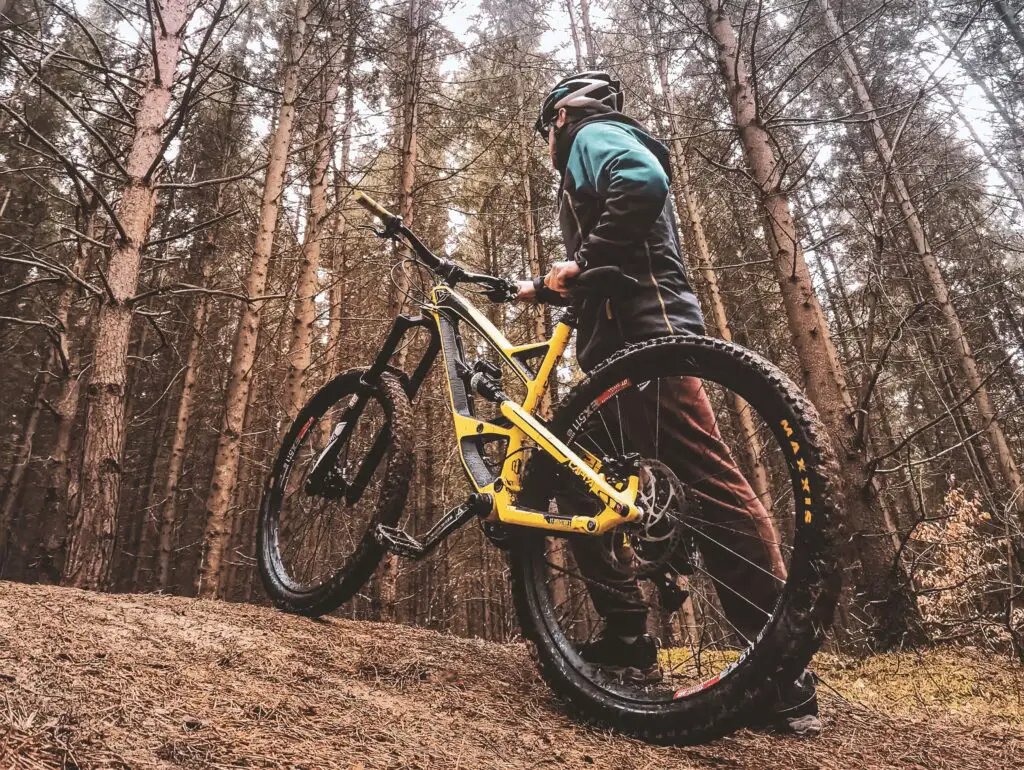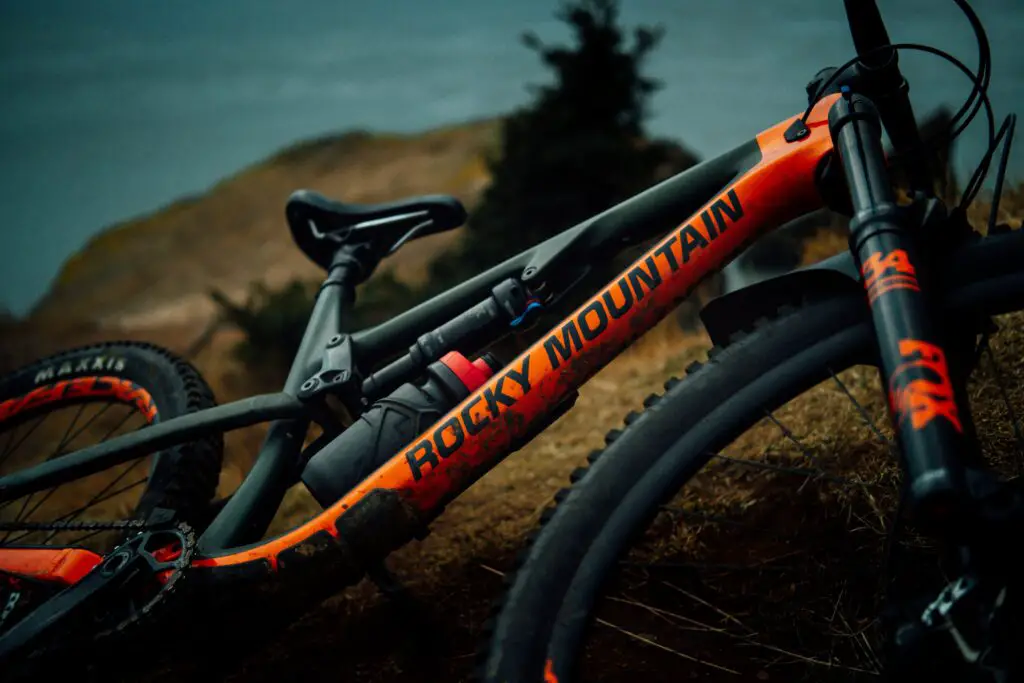There are more options than ever when it comes to selecting a mountain bike, with each type of bike being better suited to certain applications.
In this article we’ll evaluate how effective enduro bikes are at climbing, and how they stack up against the other MTB types.
Are Enduro Bikes Good for Climbing?
Enduro bikes are capable climbers. However, whilst capable enough to complete mandatory climbs in enduro events, they are primarily designed for maximum speed on downhill sections. XC bikes and trail bikes are lighter, and are typically more suited to climbing.
Table of Contents

What are Enduro Mountain Bikes Used For?
Enduro bikes are designed to perform well in enduro events in which the riders tackle a range of obstacles from rapid technical descents, huge drop-offs, and grueling climbs.
In competitive enduro events, the riders are scored based on the times they achieve across a number of downhill stages.
There are compulsory uphill sections that the riders must complete within a time limit, however, the time achieved on these uphill sections does not contribute to the score in an enduro event.
It’s important to understand how enduro events work, as this ultimately dictates the major design features of enduro bikes which will affect your riding even if you don’t compete.
So, considering the scoring system of enduro events, it’s clear that enduro bikes are designed to maximize downhill speed, whilst also being capable of climbing to the next timed section.
Therefore, whilst climbing performance isn’t the main factor driving the design of an enduro bike, it is a consideration for bike makers to ensure they climb well enough.
Now we know enduro bikes are capable of climbing at least reasonably well, let’s look at some of the key attributes of an enduro bike in relation to climbing performance and compare them to other popular mountain bike types to draw some conclusions.
How Well do Enduro Bikes Climb?
To answer this question, let’s compare some of the key features of an enduro bike to those of XC and trail bikes to see how they stack up.
Side Note: Downhill bikes are specialized bits of kit that are designed purely to get down hills as fast as possible. They’re virtually useless at going uphill so we’ve left them out of this comparison.
What Makes a Mountain Bike a Good Climber?
How suitable a bike is for climbing depends on a number of factors, including the weight of the bike, the wheel weight & size, the suspension setup, bike geometry, and gearing.
Let’s dive into each of these categories in more detail and see how well enduro bikes are suited to climbing:
Bike Weight
When it comes to climbing, a lighter bike is better. A lighter bike means less weight acting against you going up the hill, so less gravity to overcome.
Enduro bikes are relatively heavy when compared to XC bikes and trail bikes. They have heavier more robust frames in order to cope with big drop-offs and high-speed techy downhill sections.
They also have thicker forks with greater travel, and larger brakes to provide the additional stopping power required for steep decents.
The additional weight of enduro bikes compared to XC and trail bikes makes them that bit harder to climb on.
Wheel Size & Weight
The best wheel size for climbing depends largely on the nature of the climb.
As we’ve already seen, a lighter bike is better at climbing so it’s easy to assume a smaller wheel diameter is superior. A smaller wheel is a lighter wheel if the rim materials and tires are the same.
It’s not quite that simple. 27.5-inch wheels will weigh less than equivalent 29ers, making them a better option for riding up fire roads or non-technical climbs.
The benefit of 29ers is they’re able to roll over rocks and other obstacles on technical climbs more easily.
For smoother climbs with few obstacles, smaller diameter wheels are preferred. For those rocky accents, 29ers are best as they’ll roll over obstacles more easily than a smaller wheel.
Wheel size is only one aspect affecting wheel weight. Whether a bike is riding 27.5 or 29 inch tires, lightweight rims and tires will definitely make riding uphill easier.
Enduro bikes are common with either 27.5 inch or 29 inch tires, however, they also typically have heavier rims and tires than either XC or trail bikes so they typically climb slower.

Suspension Setup
The optimal suspension setup for climbing is again dependent on the terrain being climbed. For smooth tracks like fire roads, you can’t beat a hardtail.
The lack of rear suspension on a hardtail means there’s far less energy lost during force transfer from the pedals to the wheels. On a full suspension bike, more energy is lost as a result of unwanted compression of the rear suspension.
Enduro bikes are full sus, and so again a hardtail XC bike will beat an enduro bike up a fire road every time.
For more technical climbs or single tracks with loose gravel however, the additional grip provided by rear suspension is beneficial.
In this case, a full sus bike will grip the trail better, whereas a hardtail is prone to slipping and therefore wasting energy. For those more technical climbs, a trail bike or an enduro bike could well outperform a hardtail XC bike.
That said, a full sus XC bike would provide the added benefit of rear suspension without the additional weight of an enduro bike and so again would beat an enduro to the top.
Bike Geometry
The major bike geometry factors to consider for climbing performance are seat tube angle and head angle.
Enduro bikes have a steep seat angle that is well suited to climbing. A steep seat angle centers the rider’s weight over the bottom bracket making pedaling more efficient. XC bikes have steep seat angles for the same reason.
The head angle of an enduro bike is relatively slack when compared with trail and XC bikes. This can make the steering feel less responsive which can be a detriment to climbing.
On the flip side, a steeper head angle can reduce the likelihood of looping out, so can be a useful feature on very steep climbs.
Gearing
Gear ratios on enduro bikes are more than suitable for uphill sections. As we’ve mentioned, whilst the climbs in an enduro event aren’t timed, they are compulsory.
And as we’ve seen that weight saving isn’t the number one consideration on enduro bikes, adding additional low-end cogs on the cassette of an enduro bike is a small price to pay for favorable ratios when heading uphill.
Quick Answer: How Well do Enduro Bikes Climb?
Enduro bikes climb well enough to meet the demands of enduro events. Whilst they are capable climbers, a lighter-weight XC bike will typically perform better uphill, as will many trail bikes. Optimizing climbing performance is not a key factor in enduro bike design.
Which Type of Mountain Bike is Best for Climbing?
A hardtail XC bike will climb smooth uphill sections the best. For more technical climbs, a full suspension XC bike is preferable due to the additional grip granted by the rear suspension. XC bikes climb better than enduro bikes and trail bikes because they weigh less.
Which Type of Bike is Best for You?
If your main objective with a bike is to climb as quickly and efficiently as possible, you should get an XC bike. A hardtail XC bike for smoother hill climbs or a full sus for technical accents.
If however, you’re not looking to solely optimize for climbing performance, you should consider what you’re going to use your bike for most often.
To simply get to the top of a hill and then hammer down as quickly as possible, sending massive drops along the way, go for an enduro bike.
If you want to ride cross-country, get an XC bike. For anything in-between, a trail bike is likely the most versatile middle ground and will keep the most riding options open to you.
How to Make an Enduro Bike Climb Better
Whilst enduro bikes aren’t the best option for out-and-out climbing performance, there are a number of modifications that can improve their climbing qualities.
Lightweight Wheels & Tires: Replacing the rims and tires of an enduro bike for a lightweight option reduces the force required to get the wheel moving, and reduces the weight of the bike making those tough climbs that bit easier.
Firm-up Suspension: Firming up the suspension will minimize energy losses, making pedaling more efficient.
Smaller, Lighter Brakes: If you don’t need all the stopping power of your big, heavy enduro bike brakes, changing them out for a lighter set will save weight and reduce the required effort to complete a climb.
Improve the Rider: Ultimately and enduro bike is capable of climbing, even if it’s not designed to do so as optimally as an XC or trail bike. The best way a rider can make those challenging climbs easier or faster is to improve their fitness and climbing technique, regardless of the bike they’re climbing on.
